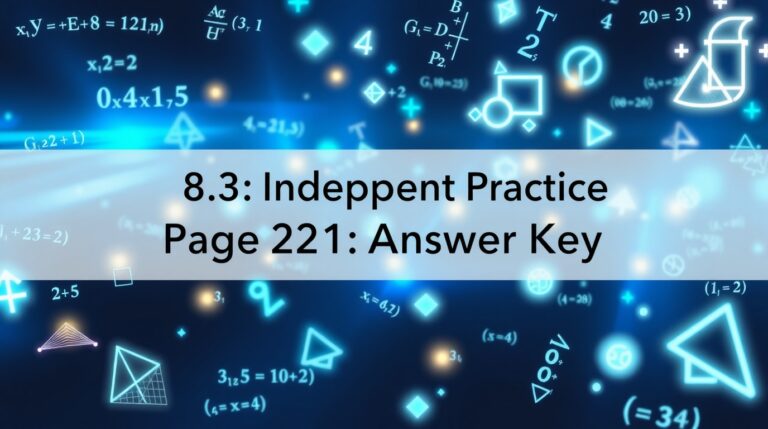Are you ready to dive into the world of independent practice? Whether you’re a student eager to sharpen your skills or an educator looking for effective resources, understanding how to navigate through exercises like the 8.3 Independent Practice on Page 221 can make all the difference. This section is designed not just as a set of tasks but as a valuable opportunity for growth and mastery. By honing your skills independently, you unlock potential that paves the way for future success. Let’s explore why this practice is essential and how you can tackle it effectively!
Understanding Independent Practice
Independent practice refers to exercises or activities that learners undertake without direct supervision. This self-directed approach fosters a deeper understanding of concepts by encouraging exploration and problem-solving.
When students engage in independent practice, they take ownership of their learning journey. It allows them to apply what they’ve learned in class at their own pace. This process is crucial for reinforcing skills and retaining information long-term.
Furthermore, independent practice cultivates critical thinking abilities. Students learn to assess problems, strategize solutions, and reflect on their methods.
In addition to academic growth, this type of practice also builds confidence. As learners tackle challenging tasks independently, they develop a sense of accomplishment that propels them forward in their educational endeavors.
Importance of Practicing Independently
Practicing independently is a crucial aspect of mastering any subject. It empowers learners to take control of their educational journey. When students tackle problems on their own, they build confidence in their abilities.
Independent practice fosters critical thinking skills. By working through challenges without guidance, individuals learn to develop solutions creatively. This self-reliance encourages deeper understanding and retention of concepts.
Moreover, practicing alone allows for personalized pacing. Everyone learns differently; some may need more time with certain topics while others can move quickly through material. Independent practice accommodates these diverse learning styles.
This approach also instills a sense of responsibility and discipline. Students who engage in independent work often find themselves more motivated to succeed, as they see the direct impact of their efforts on results.
Embracing independent practice cultivates lifelong learning habits that extend beyond academic settings into everyday life.
Tips for Effective Independent Practice
Establish a routine. Consistency is key when practicing independently. Set aside dedicated time for your studies each day.
Create a conducive environment. Find a quiet space free from distractions. This can significantly boost your focus and productivity.
Use varied resources. Explore different materials like videos, textbooks, or interactive apps to keep the learning process engaging.
Set specific goals for each session. Break down larger topics into manageable tasks to track your progress effectively.
Take breaks as needed. Short intervals of rest help maintain concentration and prevent burnout during longer study sessions.
Seek feedback whenever possible. Sharing insights with peers or mentors can provide clarity on challenging concepts and enhance understanding.
Stay motivated by rewarding yourself after completing tasks or reaching milestones within your independent practice journey.
Common Challenges in Independent Practice
Independent practice can be rewarding, yet it often comes with hurdles. One common challenge is maintaining motivation. Without external deadlines or peer pressure, it’s easy to lose focus.
Another issue many face is time management. Distractions at home can derail a study session quickly. It takes discipline to carve out uninterrupted time for practice.
Understanding the material itself can also pose difficulties. Some concepts may become overwhelming without guidance from a teacher or tutor. This confusion can lead to frustration and decreased confidence in one’s abilities.
Additionally, self-assessment proves challenging when working alone. Identifying mistakes becomes tricky without someone else’s perspective to offer constructive feedback.
These obstacles are normal but manageable with the right strategies and mindset. It’s important to recognize them as part of the learning journey rather than insurmountable barriers.
Answer Key for Page 221
The answer key for Page 221 is a valuable tool for students tackling the 8.3 Independent Practice exercises. It provides direct solutions to the problems posed, making it easier to verify understanding and accuracy.
Using this resource effectively can enhance learning outcomes. Students should attempt each problem first before consulting the answers. This method reinforces problem-solving skills and builds confidence.
For teachers, sharing the answer key can facilitate discussions in class. It opens avenues for clarifying concepts that may be challenging for some learners.
Remember, while having access to answers is beneficial, the goal remains mastery of content through thoughtful engagement with each practice question. Use the key as a guide rather than a crutch; true comprehension comes from grappling with material independently before seeking out validation in provided solutions.
How to Use the Answer Key
Using the answer key for 8.3 Independent Practice on page 221 can enhance your learning experience. Start by attempting the problems on your own first. This allows you to gauge your understanding and identify areas needing improvement.
Once you’ve completed the exercises, refer to the answer key. Check each response carefully, noting where you went wrong or what concepts need clarification.
Don’t just look at correct answers; analyze how they were derived. Understanding the reasoning behind solutions deepens comprehension.
If you’re still unclear about certain questions after reviewing, take time to revisit relevant materials or seek help from a teacher or classmates.
Utilizing this approach fosters independent learning while building confidence in problem-solving skills.
Additional Resources for Independent Practice
To enhance your independent practice, consider exploring online platforms dedicated to educational resources. Websites like Khan Academy and Coursera offer a variety of courses that align with different subjects. These can serve as excellent supplements to your learning.
You might also find downloadable worksheets on sites such as Teachers Pay Teachers or Education.com. These materials often cater to specific grade levels and topics, providing extra practice tailored to your needs.
Don’t overlook the power of study groups. Collaborating with peers can introduce new perspectives and techniques that enrich your understanding.
Many libraries provide access to tutoring programs or workshops aimed at bolstering independent skills. Tap into these local resources for guided support when needed.
Conclusion
Mastering independent practice is a vital step in the learning journey. Engaging with material on your own fosters deeper understanding and retention of concepts. By utilizing resources like the 8.3 Independent Practice Page 221 Answer Key, students can verify their work and identify areas for improvement.
The importance of practicing independently cannot be overstated. It builds confidence and prepares learners for future challenges. With thoughtful strategies and an awareness of common pitfalls, anyone can enhance their study habits.
Remember to make good use of additional resources that complement your practice efforts. Whether it’s seeking help from peers or exploring online tools, support is often just a click away.
As you navigate through your studies, keep these insights in mind to ensure effective independent practice leading to success in academics and beyond.











